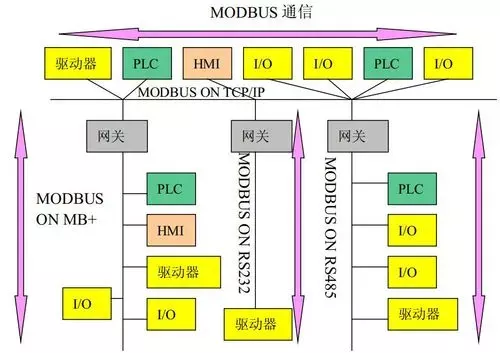모드버스 프로토콜은 1979년 모디콘에서 개발한 메시징 구조입니다. 지능형 장치 간의 클라이언트-서버 통신을 설정하는 데 사용됩니다.
모드버스는 표준 통신 프로토콜로 자리 잡았으며 이제 산업용 전자 장치를 연결하는 데 일반적으로 사용되는 수단입니다. 공개적으로 공개되고 로열티가 없기 때문에 산업 환경에서 널리 사용됩니다.
모드버스 프로토콜에는 크게 세 가지 변형이 있습니다:
- 모드버스 RTU(원격 터미널 장치) - 직렬 통신에 사용되며 모드버스에서 가장 일반적으로 사용할 수 있는 구현입니다.
- 직렬 통신에 사용되며 프로토콜 통신을 위해 ASCII 문자를 사용하는 모드버스 ASCII.
- 모드버스 TCP/IP 또는 모드버스 TCP - 포트 502를 통해 연결하여 TCP/IP 네트워크를 통한 통신에 사용되는 모드버스 변형입니다.
모드버스 프로토콜 사용의 몇 가지 장점은 다음과 같습니다:
- 오픈 소스 프로토콜입니다.
- 모드버스 메시지는 메시징 구조가 간단하여 배포하기가 어렵지 않습니다.
- 모드버스는 원시 단어와 비트를 이동하며 제한이 거의 없습니다.
- 드라이버가 이미 설치되어 있고 이더넷 및 TCP/IP 소켓에 익숙하다면 몇 시간 안에 드라이버를 작동하고 PC와 데이터를 교환할 수 있습니다.
모드버스 프로토콜 사용의 몇 가지 단점은 다음과 같습니다:
- 모드버스는 하나의 데이터 링크에서 247개의 장치를 주소 지정하는 것으로 제한되어 마스터 스테이션에 연결된 필드 장치 수가 제한됩니다(이더넷 TCP/IP는 예외임).
- 모드버스는 1970년대 후반에 프로그래머블 로직 컨트롤러와 통신하기 위해 설계되었으며, 데이터 유형의 수가 제한적이었습니다.
- Modbus/TCP는 보안 통신 프로토콜이 아닙니다. Modbus/TCP는 장치 간 통신 시 보안 또는 암호화를 사용할 수 있는 옵션을 제공하지 않습니다. 따라서 자동화 시스템에서 잠재적인 보안 취약점이 발생할 수 있습니다.

찾고 계십니까? PLC I/O 커플러? 자세히 알아보려면 클릭하세요!
